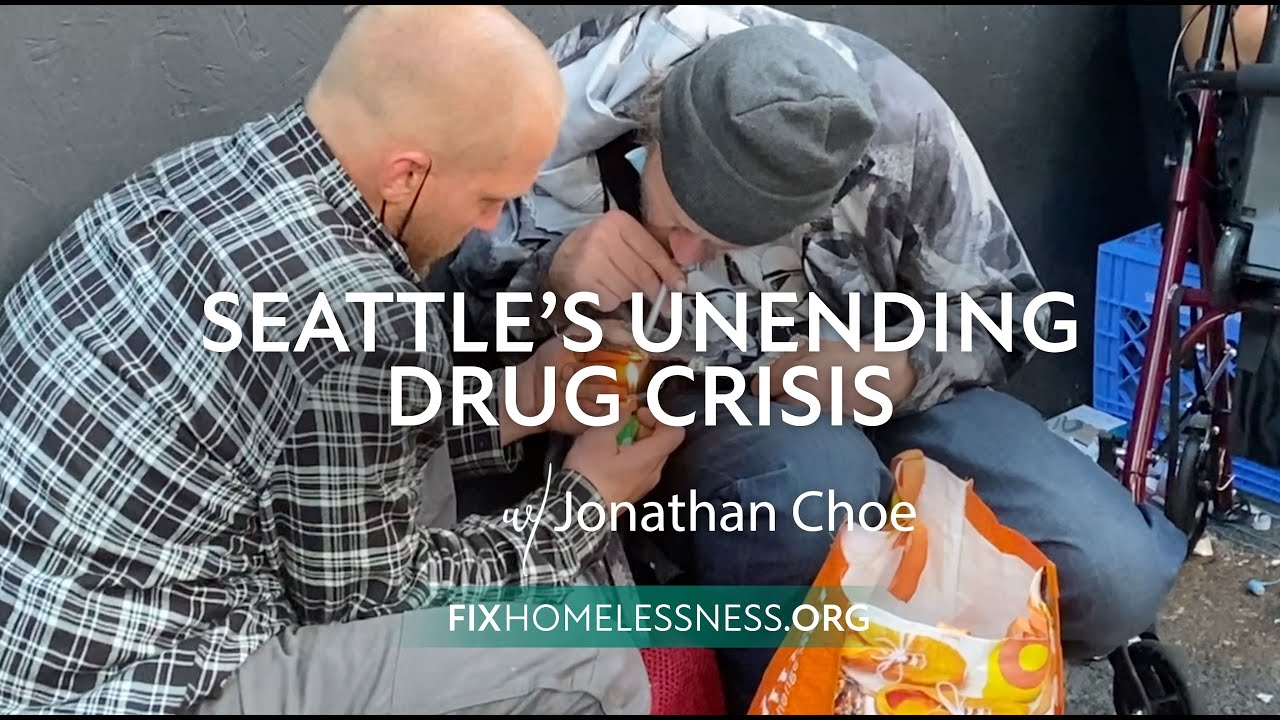Seattle’s Unending Drug Crisis
Published at Fix HomelessnessIn this great American city, blessed with enormous wealth and natural beauty, a drug crisis is exploding on its streets.
Along 3rd Avenue, against the backdrop of Pike Place Market in Seattle’s downtown core, the addicts smoke and inject all kinds of substances in plain sight.
The current drug of choice is fentanyl, often sold as “blues” pills. Aaron Smith shows me how he inhales with a hollowed-out pen. Today it’s three for ten dollars; tomorrow it could be even cheaper. The drug dealers prey on these lost souls.
Smith says, the drug “relaxes your body; it relaxes your mind…. It makes you feel comfortable; it helps you be comfortable in all these tough conditions.”
Fentanyl overdose deaths are surging this year in King County and are now on a record pace. “The fire chief in Seattle told me a few months ago they respond to four overdoses every day,” says Washington Senator Patty Murray. Health officials say it’s one of the main causes of homeless people’ dying on the streets.
Since June, the Seattle Fire Department responded nearly 200 times to this stretch of 3rd Avenue between Union and Pine streets. Again, most of it is related to drugs.
Many addicts admit to stealing from nearby businesses to fuel their habits. They bring the things they steal to 3rd Avenue to sell for pennies on the dollar. Clothing, beer, paper towels—anything for a quick buck to buy more pills.
The eco-system is spilling on to nearby streets. Earlier this year, Amazon exited the Bon Marche building, citing neighborhood safety concerns. The tech giant also recently closed down its nearby GO store on 4th Avenue for the same reason.
A block away in West Lake Center, the iconic Starbucks also shut down, saying workers no longer felt safe in the area. And Piroshky Piroshky says its downtown location will remain closed indefinitely.
Westlake Park is also turning into an open-air drug den at night. Users continue to smoke up in doorways and leave trash all over the ground.
“I’m from the Bay Area San Francisco, and we see a lot out there—but nothing like this,” says Glenn Nelson.
The data is grim. And allowing the human toll to continue is unconscionable to community advocate Rick Hearns. That’s why he’s out here, pleading with these men and women to get help.
“I think it’s going to take more deaths. I hate to say it but it’s going to take some tragedy to make some changes,” says Hearns.
Some non-profits and local faith-based groups like REACH Ministry have also attempted to intervene.
So has Mayor Bruce Harrell. At a recent press conference focused on crime, he stated,
“Safety as Mayor is my core charter responsibility.” In March, he cleared the illegal activity on 3rd Avenue after several shootings and the death of a teenager.
Seattle Police added more patrols. The mayor even temporarily closed down the bus stop at 3rd Avenue and Pine Street to slow down the flow of illegal activity.
It seemed to be working. At times, the area even looked completely clear. But now, crime and drug use have come roaring back. Some say it never truly went away.
The Harrell Administration has not responded to my requests for comment on these new concerns.
Jim Fuda with Crime Stoppers Puget Sound says criminals and addicts know that Seattle police is down hundreds of officers. Crime has “become attractive…that’s why it’s grown,” he says.
While arrests are still happening out here, it’s unclear how often SPD plans to go after people doing drugs in the open. “They’re doing what they can with what they have,” says Fuda.
Even though city attorney Ann Davison says she wants to go after repeat offenders, Fuda believes there will likely be limited prosecution of misdemeanors such as petty theft and drug use. We asked Davison how many drug and theft cases she’s charged since taking office earlier this year. We’re still waiting for her to get back to us.
Fuda describes the situation as a “revolving door.” He laments that except for “crimes against a person, a violent crime, they’re back on the street,” says Fuda. He says until this changes, the cycle of lawlessness in Seattle will continue.
On any given night, 3rd Avenue and Pine feels like a block party. One man proudly walks around in his underwear while a group of guys drink beers on a couch they just brought in. The black market is thriving and musicians now add to this eclectic mix of illegal activity.
Tourists are usually unaware until they walk right into this mess.
Wiler (he only wants me to use his first name) is visiting from Boston for the summer. Seeing people passed out on the sidewalk and “geeking out,” he says it will be his final trip to the Emerald City: “No never, I would never come back.”
